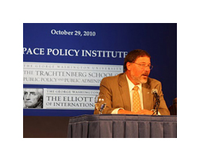Report from Washington, D.C.
Pulham Speaks at GWU Symposium
Written by: developer
 Space Foundation CEO Elliot Pulham attended the George Washington University Space Policy Institute and Trachtenberg School symposium, From Vision to Execution: Implementing U.S. Space Policy, on Oct. 29. He spoke on the panel, “Implementation Issues and U.S. Industry,” along with fellow panelists: Marion C. Blakey, president and chief executive officer of the Aerospace Industries Association; and Robert S. Dickman, executive director of the American Institute of Aeronautics and Astronautics.
Space Foundation CEO Elliot Pulham attended the George Washington University Space Policy Institute and Trachtenberg School symposium, From Vision to Execution: Implementing U.S. Space Policy, on Oct. 29. He spoke on the panel, “Implementation Issues and U.S. Industry,” along with fellow panelists: Marion C. Blakey, president and chief executive officer of the Aerospace Industries Association; and Robert S. Dickman, executive director of the American Institute of Aeronautics and Astronautics.
Pulham said the new national space policy is not a bad one. “There are some areas of concern, but largely the new U.S. National Space Policy provides a solid framework. But implementation is going to be tough,” he said. “To implement a policy it has to be implementable. There are aspects of this policy that are not implementable, such as the NASA section.”
His concerns included:
- The policy doesn’t address the issue of sustainability and the findings of the Augustine committee.
- The funding levels in the FY 2010 NASA Authorization Act are unsustainable.
- NASA is supposedly going to rely on “commercial” providers to address cost issues, “However, true commercial is about walking into a Rocket’s R’US and being able to choose an Atlas V and/or a Falcon 9. That’s how you get competition and create lower prices. Instead, what we have going forward is government-funded development of launch systems,” said Pulham.
- After the Space Shuttle retires next year, the U.S. will have to rely on the Russians and unproven commercial providers. The U.S. should not be without its own national means to access space.
According to Pulham, aspects of the new policy that are implementable include:
- The international piece, however, “to date there have been no plans on collaboration. International partners are saying they need to see some real concrete ideas on what that collaboration looks like.”
- The implementation of fixing ITAR issues “appears to be happening pretty quickly in this administration, but we still have a ways to go before ITAR issues are resolved.”
So what does sustainability look like, according to Pulham?
- A national aerospace policy as mentioned in the Final Report of the Commission on the Future of the United States Aerospace Industry (a.k.a., The Walker Report).
- A reengineered government strategic planning and budget process that looks at government aerospace policies and investments as a sector and from a long-term perspective (e.g., multi-year funding, life-cycle costing and management).
- A space leader in the executive branch who can implement national aerospace policy consistent with national security and economic goals and objectives.
- An integrated federal planning, budgeting and program management process.
- Every government agency with space responsibilities reporting to the space leader to prevent disconnects in policy implementation.
Said Pulham, “Conservatively we’ve spent $23 billion on shuttle replacements with no flight vehicle to show for it. We need to walk away from less and step up to more.”
In response to the question, “What capabilities should be in government vs. what can be pushed out to the private sector?” Pulham said, “The role of government in space is to do the things that are too hard and too risky for commercial industry to take on.”
This article is part of Space Watch: December 2010 (Volume: 9, Issue: 12).
